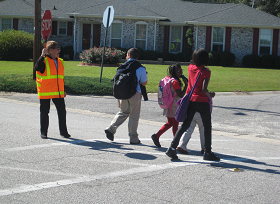Safe Routes to School (SRTS) is a national program that encourages parents, schools, community leaders and local, state, and federal governments to encourage children to walk and bicycle to school, thereby improving the health and well-being of children. SRTS programs are sponsored by schools, but typically include neighborhood involvement and that of local officials to make programs a success. Today, Safe Routes to School programs operate in all 50 states and D.C.
Why is this important to your community?
Encouraging kids to walk and bike to school is central to establishing healthy practices and encouraging physical activity from an early age. Safe Routes to School programs often include safety education which also teaches kids to be safe when walking and biking around their neighborhood in general. Safety audits conducted through SRTS programs also help to highlight barriers to walking and biking in neighborhoods surrounding schools and lead to measures that help overcome such barriers, such as reducing vehicle speeds, repairing and building sidewalks, and encouraging drivers to be more aware of cyclists and pedestrians on the streets. Furthermore, programs such as Walk and Bike to School Days encourage neighborhood and parent interaction and bring communities together around the shared goal of encouraging healthy lifestyles and supporting neighborhood schools.
Where is it appropriate to use?
What priorities does it address?
What other tools are related?
- Walking and Bicycle Audits and Planning
How does it work?
The Safe Routes to School program was established in 2005 through federal legislation, which authorized dedicated funds to be allocated to start SRTS programs around the nation. Funds are given to schools through a competitive grant process, which can be used for both infrastructure and non-infrastructure activities. Each state has a Safe Routes to School Coordinator who distributes funds and information. As important as the funding source is the involvement of parents, administrators, and city officials in advocating for increased walking and biking. A successful SRTS program begins as a partnership between neighborhood advocates, parents, schools and the city. Programs typically include safety curriculum, events such as Walk and Bike to School Days, and conducing an audit or needs assessment to determine barriers to walking and bicycling. Resources to create programs are available through the national program, the Safe Routes to School National Partnership, and state coordinators.
Ready to get started?
Using the Tool
- Establish an advisory committee for a Safe Routes to School program consisting of involved parents and school administrators. Seek funding for a grant from the state SRTS program, which administers federal funding. Initially programs may be initiated with or without funding.
- Conduct a Walking and Bicycling Audit (link) to assess the conditions for walking and bicycling around schools and identify barriers and current rates of walking and biking.
- Host events such as national Bike and Walk to School Days to encourage early support for program.
- Establish curriculum for walking and bicycle safety as part of physical education classes. Use org and SafeRoutesPartnership.org as resources to build curriculum.
- Work with neighborhood partners to help fund events through in-kind services and sponsorship.
- Advertise events with parents and encourage parent support of events and long-term behavior changes.
- Identify infrastructure improvements that would enhance safety and encourage walking and bicycling. Seek funding for improvements using potential SRTS funding or working with city planners as part of a capital improvement plan.
Partners
- Advocacy Groups
- Colleges and Universities
- Community Development Organizations
- Departments of Education / School Districts
- Elected Officials
- Faith-Based Organizations
- Health and Wellness Programs
- Housing Authorities
- Landscape Architects, Planners, and Urban Designers
- MPOs, RPOs, and COGs
Where has it worked?
Olde Providence Elementary School - Charlotte, NC
 Image Source: Charlotte-Mecklenburg Schools.
Image Source: Charlotte-Mecklenburg Schools.
Contact
Dick Winters, AICP, Built Environment & Safe Routes to School Coordinator
dick.winters@mecklenburgcountync.govAbout the Program
Olde Providence Elementary School’s program began with a parent’s request for a bike rack at the school so her children could ride. That request led to the school’s PE teacher partnering with Mecklenburg County Health Department to have students participate in a neighborhood Photo voice project to capture safe and unsafe elements of their walks/rides to school. Next steps involved developing and delivering a bicycle and pedestrian safety education class. The PTA and parents were recruited to determine safe meeting places in the surrounding neighborhoods with complete routes to the school. The first big walk/bike event was International Walk to School Day in 2009. Since then, the school has significantly increased the frequency of walking/bicycling events to twice a week during daylight savings time months. The school has consistently had a range 150-500 participants in its events and significantly reduced personal vehicle usage by parents on event days.
Why it works
The school’s Principal and PE teacher were strongly behind getting their students to safely walk or bicycle to school and supported getting parents involved from the beginning. The PE teacher was the person who continually championed getting the word out and keeping parents involved. The PE teacher also supported teaching all grade levels how to walk and bicycle safely as a fun and healthy life skill and was instrumental in getting other PE teachers in Charlotte Mecklenburg Schools interested in teaching bicycle and pedestrian safety. CMS had a small fleet of bicycles that schools could use for the classes and has successfully increased its fleet to about 150 bikes covering all sizes for students through in all grades. The bicycle safety classes also provided instruction for students who did not yet know how to ride a bicycle, regardless of age. This model and variations have been successfully implemented at other CMS schools.
Sherwood Forest Elementary School - Winston-Salem, NC
 Image Source: Judi Lawson Wallace.
Image Source: Judi Lawson Wallace.
Contact
Sharon Sturkie, SRTS Chairperson for Sherwood Forest Elementary School
ssturkie@triad.rr.comAbout the Program
Winston-Salem’s Sherwood Forest Elementary School’s SRTS program began without a grant, but rather with interested parents, collaboration with the City of Winston-Salem, and donations from local businesses. The program began in 2006, when less than 1% of students walked to school and none biked. The most-cited barrier to walking and bicycling was overwhelmingly safety. The program sought to change behavior by altering perceptions of safety through improvements to routes and education. Sherwood Forest Elementary School is in the process of applying for an infrastructure grant from North Carolina’s SRTS to fill critical sidewalk gaps to make the routes safer for much of the neighborhood.
Why it works
Citing lack of sidewalks as the biggest barrier to walking and bicycling to school, with missing connections, and lack of crosswalks, school officials worked with the City to identify potential areas for new sidewalks. The City agreed to paint several new crosswalks to improve the route as well as fill in a small length of sidewalk that would provide a connection to existing sidewalks. One major concern had been developing a sidewalk for Kirklees Road, a major artery through the neighborhood, which will be paid for by the infrastructure grant, if received.
Partnerships and donations from neighborhood partners and businesses also helped get the program off the ground. A SRTS committee was established of approximately a dozen members to focus efforts on walking. Four “Walk to School With Us This Friday” events were held, coinciding with School Spirit Days, where children wore their school T-shirts. A local printing business donated the printing for fliers to advertise the events, and those were placed in student folders; the printers also donated buttons that say “I rock because I walk” for participants once they reach the school. School officials hung a banner to remind students and parents to “Walk to School With Us This Friday.” Peace Haven Baptist Church, a partner in the program, agreed to allow parking for families who live too far from the school to walk, so they can participate in the events. Volunteers were stationed along the three-quarters of a mile route to ensure safety at crosswalks and to hand out orange slices to pedestrians. Parents were encouraged to walk with the kids to school. The response has been positive, with participation ranging from 125 to 175 people at the events. The program expects to grow with attendance in the events and encouragement of everyday walking.
Spartanburg County SRTS - Spartanburg, SC
 Image Source: SC DOT.
Image Source: SC DOT.
Contact
Laura Ringo, Safe Routes to School Coordinator
Partners for Active Living
South Carolina Department of Transportation Spartanburg Area
P.O. Box 6728 Spartanburg, S.C. 29304
LRingo@active-living.org
864-598-9638About the Program
Spartanburg County’s Safe Routes to School (SRTS), which began in 2007, has its foundation in teaching safety, improving the condition of the physical environment, and using outreach to increase the number of families capable of walking to school. The program has involved three elementary schools in the county: Pine Street Elementary, Lone Oak Elementary, Inman Elementary School.
In 2007 and 2008, these schools received a total of $400,000 in Federal Safe Routes to School funding administered through the South Carolina Department of Transportation (SCDOT) to begin the program. The grant funds were focused on both education and outreach, as well as infrastructure improvements and increased staffing and safety monitoring.
Why it works
The program began with piloting safety curriculum to increase students’ understanding of safe pedestrian and bicyclist habits, which was incorporated into health and physical education classes. To promote the program and encourage students to walk or bike to school, parent- teacher organizations distributed fliers during school dismissal and send out newsletters. Events such as “Park and walks” to school and “walking school buses” were designed to implement this habits through participation. Student volunteers served as safety patrollers to model safe behavior to other students. “Walking and Wheeling Wednesdays” and “Walk and Bicycle to School Day” were celebrated at the schools. Pine Street Elementary School even used an incentive program to encourage students to participate in these special days.
The program also paid for infrastructure improvements to physically improve safety conditions, such as connectivity improvements, signage and crosswalk markings at the schools. It was made clear to the community, through announcements, that this improvement was made to aid in safety and encourage more walking and bicycling. More crossing guards, additional bike racks, and more progressive ticketing was also part of the program.
Partnerships with advocate groups, public health agents, and neighborhood associations were also an essential element of the program. Organizations like Partners for Active Living, Safe Kids of Spartanburg were constantly engaged, as well as the newly-formed Childhood Obesity. Elected officials also supported the program.
Over the past couple of years, community support has grown and is still growing as organizations and community members are beginning to understand the importance of alternative transportation at schools. The program encouraged regular walking and bicycling to school, making it so safe, convenient, and cool that it becomes a realistic choice for transportation. The program has been an overwhelming success. In 2008, Spartanburg hosted the most successful Walk to School event in South Carolina, with more than 44 schools across the county participating, and rates of walking and bicycling has increased every year.
- Colleges and Universities


